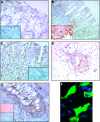Card15 gene overexpression in mononuclear and epithelial cells of the inflamed Crohn's disease colon
- PMID: 12740340
- PMCID: PMC1773666
- DOI: 10.1136/gut.52.6.840
Card15 gene overexpression in mononuclear and epithelial cells of the inflamed Crohn's disease colon
Abstract
Background: Crohn's disease is one of the principal human chronic inflammatory bowel diseases. Although its aetiology is still unknown, its complex pathogenesis has environmental, immunological, and genetic determinants. CARD15 is the first susceptibility gene implicated in the predisposition to Crohn's disease and is known to be expressed only in monocytes. However, its expression in situ has not yet been studied.
Aims: To analyse the tissue distribution of CARD15 and identify cells producing CARD15 in samples of colon from patients with Crohn's disease and control subjects.
Patients and methods: We analysed CARD15 gene expression in surgical specimens of colon from eight children with Crohn's disease and nine controls by immunohistochemistry, in situ hybridisation, and reverse transcription-polymerase chain reaction (RT-PCR).
Results: We showed that CARD15 was present only in the cytoplasm of macrophages in the normal colon. Increased CARD15 expression was detected in Crohn's disease lesions. There were more CARD15 positive cells in Crohn's disease lesions than in uninvolved areas. Both intestinal epithelial cells, macrophages, and their derivatives overproduced CARD15 in Crohn's disease. To further assess CARD15 expression by intestinal epithelial cells, we performed RT-PCR on freshly isolated intestinal epithelial cells, and showed that these cells isolated from Crohn's disease samples contained more CARD15 mRNA than intestinal epithelial cells from controls.
Conclusions: We have demonstrated that colonic involvement in active Crohn's disease is associated with increased CARD15 gene expression in both macrophages and intestinal epithelial cells. Therefore, this deregulation can affect the host-environment interaction and thus contribute to the pathogenesis of this disease.
Figures




References
-
- Fiocchi C. Inflammatory bowel disease: etiology and pathogenesis. Gastroenterology 1998;115:182–205. - PubMed
-
- Hugot JP, Chamaillard M, Zouali H, et al. Association of NOD2 leucine-rich repeat variants with susceptibility to Crohn’s disease. Nature 2001;411:599–603. - PubMed
-
- Ogura Y, Bonen DK, Inohara N, et al. A frameshift mutation in NOD2 associated with susceptibility to Crohn’s disease. Nature 2001;411:603–6. - PubMed
-
- Rioux JD, Daly MJ, Silverberg MS, et al . Genetic variation in the 5q31 cytokine gene cluster confers susceptibility to Crohn disease. Nat Genet 2001;29:223–7. - PubMed
-
- Lawrance IC, Fiocchi C, Chakravarti S. Ulcerative colitis and Crohn’s disease: distinctive gene expression profiles and novel susceptibility candidate genes. Hum Mol Genetics 2001;10:445–56. - PubMed
MeSH terms
Substances
LinkOut - more resources
Full Text Sources
Medical
